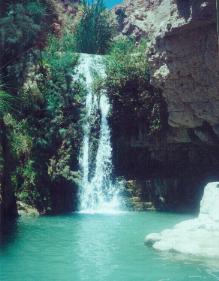
Nahal David waterfall
 Nahal David waterfall |
There are times, especially in the middle of summer or a drought stricken winter, when I yearn for water. No, not a drink of water, not a bath or a shower, but just to see a body of water and lush green plants. I want to escape from the total lack of visible water that is central Israel in the middle of summer. Yes, I could just take a bus to Tel Aviv's beach (only an hour away) or visit the lovely, but artificial ponds at the nearby Neot Kedumim nature reserve, but somehow that doesn't do it. I want to see natural water and vegetation. I want to see paradise - in short I want to take the day off and go to Ein Gedi. Good thing it's only an hour and half's drive from where I live.
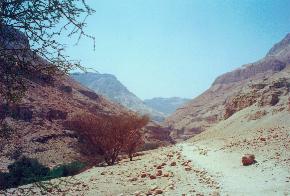 Nahal Arugot, Ein Gedi. |
Ein Gedi is a lush oasis set between the harsh Judean Desert and the sterile Dead Sea. Below the craggy cliffs, nestling in the rocky canyons of Nahal David and Nahal Arugot are seemingly miraculous fresh water springs flowing into clear streams and waterfalls, all that is needed to bring this corner of the desert to life.
And alive is the word for it. The mix of desert, cliffs and water create diverse habitats for both plants and animals, some tropical, others native to desert regions and still others native to more temperate Mediterranean environments. The wealth of birdlife makes it a wonderful birdwatching spot, while the interesting mix of plants and trees attract many botany enthusiasts.
Here you'll find small snails and crabs by the edges of secluded streams with bright red and blue dragonflies hovering above, while jewel coloured kingfishers and little green bee-eaters perch on branches over the water. Occasionally there will be a flash of green or turquoise feathers as one of the birds darts out after prey, the bee-eaters deftly catching flying insects on the wing, the kingfishers diving into the water or onto the banks after small amphibians, lizards or invertebrates.
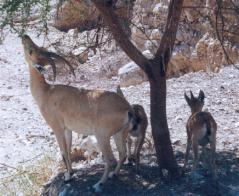 Ibex family |
From the trees along the banks and in the floor of the canyons comes pleasant birdsong, the bubbling and chattering of the bulbuls, distinct flute like calls and whistles of the Tristram's grackles, the gentle warbling of blackstarts and the high pitched trills and cheeps of sunbirds. Every so often a grackle (or two or four or five...) will whizz by in a streak of bright orange and black making a noise that sounds very much like a wolf whistle.
The clattering of rocks and scree from the cliffs above is a sign that there are ibex around. Look up and you'll see one or more of these nimble wild goats deftly making their way along the treacherous ledges. These are the goats for whom Ein Gedi, Goat's Spring in Hebrew, is named.
While you're looking up you'll notice where the loud cawing and cooing noises are coming from, the high cliffs are home to doves and ravens, many of the later soaring above the canyons. Small reddish-brown hyrax occasionally dart across the canyon floor. These timid creatures generally hide in or under rocks when startled, but if you're very quiet and still you'll see them grazing on desert scrub or clambering along a tree branch munching on leaves.
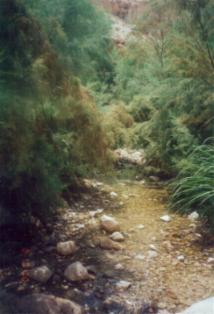 Nahal Arugot, Ein Gedi. |
Many of Ein Gedi's other residents, such as red and Afghan foxes, caracals, wolves and striped hyenas are nocturnal. The reserve is one of the last refuges for another nocturnal predator. the leopard. Four of these big cats are known to have made their home there. As the reserve closes at four, the only way to see most of these animals is either very early in the morning (the reserve opens at 8am and some nocturnal animals are still up then) or to stay at the guesthouse or youth hostel of the neighbouring Kibbutz (communal village) Ein Gedi. The kibbutz is also home to a wonderful botanical garden featuring plants from around the world, including about 100 types of cactus.
It's not only animals who enjoy Ein Gedi's lushness though. Many people come to hike here and to enjoy the cool waters of the various natural pools and waterfalls along the trails. Part of the popularity of 'Ein Gedi is that it isn't that easy to find waterside hikes in most parts of Israel, especially not in the middle of the desert and especially not in the middle of the summer dry season. Another boon is that while there are plenty of challenging, difficult and long hikes to be had in and around the reserve, there are also some short comparitively simple ones which most people can handle without difficulty.
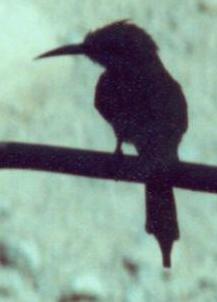 Little green bee-eater at Nahal David |
On an average weekend during the spring, summer and autumn the Nahal David walk in particular is often quite busy. The easiest stretch at the lower end of the canyon leads to a lovely natural shallow 'swimming pool' fed by a small waterfall and shaded by a rocky ledge. This pool is very popular and often it feels as though you have to wait to enjoy it between tour groups, unless you get there early enough in the morning. It's beautiful site though and very enjoyable even when it's on the crowded side.
The steeper section of Nahal David and the Nahal Arugot trails are normally quieter. The other pools in Nahal David are not for swimming in, but it's still delicious to wade in the cool water and refresh your hot feet or to stand under a small waterfall, especially in the summer when midday temperatures are often around 37-40 degrees celsius. While Nahal David offers great views of the Dead Sea, Nahal Arugot has some lovely desert vistas of its own as you walk down the canyon. There are also waterfalls and pools on the Nahal Arugot trail, such as the Hidden Waterfall which flows over a wide crevice in the rocks down into a pool squeezed between rocky crags. Even the shortest of the Nahal Arugot trails is at least two hours (others are more like 5 or 6) so it isn't usually as popular or as crowded as Nahal David, even though it's just as beautiful.
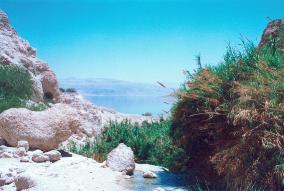 View of the Dead Sea from Nahal David |
One of the reasons I love Ein Gedi is that it mixes two of my first loves - nature and history. Ein Gedi is mentioned by name several times in the bible. In the book of Joshua (15:62) it is listed as one of the cities of the tribe of Judah, appearing in the list after a city known as 'Ir HaMel-ah', or the 'City of Salt', an appropriate name for a town in the Dead Sea region.
Ein Gedi also appears elsewere in the Bible, for example in the story of the battle between the four kings against the five kings (Genesis 14:7) and in the books of Chronicles and Ezekiel. More romantic descriptions appear in Song of Songs (1:14) "My beloved is to me like a cluster of henna flowers in the vineyards of Ein Gedi."
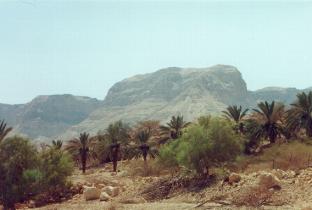 Ein Gedi |
It is the location of an emotional meeting between King Saul and David, one of the many dramatic episodes in the story of these two kings of Israel which appears in the book of Samuel. Saul displeased God and as a punishment the prophet Samuel told him that Saul's children would not rule over Israel, rather the young David would be the next king.
The story is long and complex to say the least. It features several 'chase' scenes in the Judean Desert, a land of cliffs, caves and tortuous canyons - the ideal place for an outlaw to hide from his pursuers. Saul pursues David from hiding place to hiding place, until Saul gets distracted by a Philistine invasion "And David went up from there and dwelt in the strongholds of Ein Gedi." (Samuel 1 23:29) It's not clear whether the Hebrew 'metzudot' in this case literally means a manmade fortress, or perhaps the word refers to the fortress like cliffs of Ein Gedi which form an ideal natural stronghold.
David doesn't get much respite though "It came to pass when Saul returned from chasing the Philistines he was told that David was in the wilderness of Ein Gedi. And Saul took 3000 chosen men from all of Israel and went to seek David and his men upon the crags of the ibex (wild goats)." (Samuel 1 24:1-2)
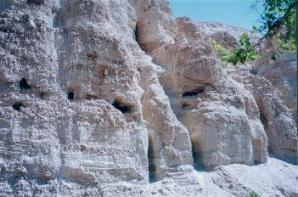 Nahal David. Many birds nest in these cliffs. |
While tracking David, Saul takes a moment to relieve himself in a cave. It just happens to be the cave in which David and his men are hiding, but Saul doesn't notice them. David's men encourage him to kill Saul, after all, it seems as though God has delivered their enemy into their hands.
David however cannot kill his king, instead he tears off a piece of Saul's cloak. Even this act of disrespect pains David and when Saul leaves the cave he runs after him and shows him the torn piece of cloth from Saul's coat. In one of the most moving exchanges in the Bible David explains to Saul that really, he does not wish Saul harm, on the contrary he could have killed him that day, but could not, for Saul is his king. Saul breaks down and cries, asking David's forgiveness for the cruel way in which he has been treated. The result is a reconciliatory pact between the two.
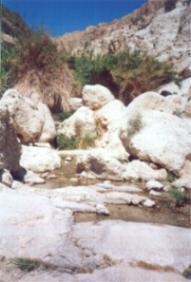 Nahal David |
Ein Gedi continued to be inhabited during the later biblical and talmudic periods, and there are many archeological finds in the area from these periods. The most striking of these is the ancient synagogue uncovered on the site complete with a beautiful mosaic floor. The quality and design of the synagogue indicate that Ein Gedi was home to a signigicant and large Jewish community. Documents from the Bar Kokhva rebellion against Roman rule have also been found in the region. Perhaps this is not surprising considering that Ein Gedi is not far from Masada, site of a mass suicide by Jews who were besieged by the Roman army during an earlier revolt between 66 and 73 CE.
The oasis continued as a thriving agricultural community until around the late 6th century or just before the Muslim Arab conquest in the late 7th century. During this period it went into decline and the site was neglected, though never actually abandoned, as nineteenth century travellers noted that some local Beduin used it's water resources to set up a mill there.
The modern kibbutz Ein Gedi dating back to 1949 has restored the site to it's former glory days as a lush agricultural community. In 1972 the area was declared a nature reserve, though visitors had been enjoying the wonders of the oasis well before then.
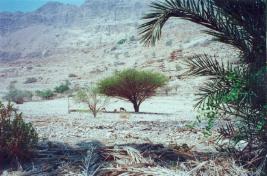 Acacia tree, Ein Gedi |
More information about Ein Gedi and the Dead Sea, including photos, is available at these sites:
Copyright 2000 by Leiah Elbaum. Text and photographs on this page are by Leiah Elbaum. Last updated 12 October 2000.